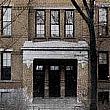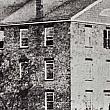
Out with the Stoves
by Diana Barrett
As Grand Rapids grew, especially in the last quarter of the 19th century, new schools were built, existing buildings enlarged with additions, and old buildings replaced. Heating and ventilation became more complex for larger two or three story buildings that required furnaces or boilers, which were more efficient for heating large spaces than stoves.
Privies were moved indoors, demanding more complex waste removal processes and ventilation systems. Complicated structures demanded more experienced planners. During this era the specialist, the school architect, emerged and replaced the master builder.
Three choices were available for heating schools: the common stove; the furnace, a large stove placed in a separate area, usually a basement, that distributed heat through connecting tubes; or steam from a boiler.
Each choice was a good and appropriate method for warming the air of a school, but each was equally worthless without a proper ventilation system. No matter the method of heating, to be efficient and effective it must have ventilation as a partner, but heating and ventilation are antagonistic processes. Therein lies the rub. Once the air in a room has been heated and becomes stale it must be removed and fresh air brought in to replace it. In northern climates, during winter, that fresh air is cold. Providing the air supply necessary for ventilation was a problem to be solved by the school architect.
Stoves, which were used to heat individual rooms, were the cheapest method of warming known at the time. In the days of one or two-room schoolhouses, plenty of ventilation was provided naturally through ill-set windows and doors or cracks in the floors, walls, and roofs. When stoves were used in the individual rooms of larger buildings ventilation became a serious issue. Superintendent Strong had complained in 1863 about the Stone School, ‘heating and ventilation are so improper and inadequate that it is safe for only the more robust pupils to attend school during the entire year.’
Ruttan System
The concept of the Ruttan System, used in some Grand Rapids schools, was developed around 1860 in Canada by Henry Ruttan,[1] a man well acquainted with cold climates. He never produced the system but Isaac D. Smead of Toledo, Ohio purchased his patent and combined it with patents by B.R. Hawley to create the Ruttan System.
Isaac David Smead was a great promoter and salesman. In 1889 he published an elaborate marketing piece that included twelve full-color plates, beautifully engraved diagrams of his system, illustrations of many schools and institutions where it had been installed, as well as a text, in question/answer format, describing the many benefits of the Ruttan method and the many pitfalls of competing systems. Smead commented on the use of boilers and steam, “There is so much [danger] that if either of my two children were attending school in many of the buildings in which I have been, I should be in constant fear for the lives.”[2]
Smead’s expressed fears were not entirely unfounded. Exploding boilers, noted often in newspapers across the country, went off like bombs, rarely with any warning and almost always with fatalities. In November of 1896 a serious boiler explosion killed approximately twenty people and destroyed the offices of the Detroit Evening Journal.
The usual suspects in these disasters were cheap boilers, poor maintenance, and inexperienced custodians. While schools do not appear to be common among boiler casualties, it is easy to imagine the fears of school boards responsible for the safety of children, and why Smead played on those fears. When boilers did become more common in the city’s schools, school boards carried “boiler and liability insurance.”
A knowledgeable reviewer of the Ruttan system wrote, “It may be said in favor of this system that it shows throughout a studied effort toward conformity to physical laws, and it is therefore a valuable contribution toward the solution of the difficult and all-important problem of ventilation. It is an ingenious system, and is doing comparatively good service.” A tubular furnace was used, which was economical and had a large surface that made it an effective heater.
The system was not without obstacles. For the Ruttan system to work efficiently a building must be constructed from the beginning with a special design for its application. In buildings not specially constructed for this system it was practically worthless, and the same was true of buildings improperly designed for it by architects who did not fully understand the scientific principles behind the system. This was not a fault of the system but it was often a major obstacle.[3]
An early example of a local school that used Smead’s system was the new West Side Union School, finished by August of 1875, and had replaced the former building at the same location. It was heated by Hawley’s Tubular hot air furnace and ventilated upon the Ruttan principle. The school had eleven rooms that could accommodate 600 pupils, stood three stories above a high basement, and measured 85 ft. by 108 ft. The walls were brick and the roof was slate with copper gutters. This new Union School offered education through the eleventh grade; those who wished to attend a senior year and graduate would do so at Central School on the east side.
Boilers and Radiators
Boilers produced heat by sending either hot water or steam through a radiator system. Because schools were not continuously occupied, steam was a more practical and efficient heating method, particularly in larger buildings and was used in many local schools. Ventilation was equally as important with this method of warming air as it was with stoves and furnaces.
Steam heat became practical when the Mills boiler was introduced in 1872. Patented by John H. Mills, his overhead system of steam and water heating presented the first radical change from earlier high-pressure boilers. The overhead piping and downward supply system of steam piping became the standard throughout the country.[4] Mills boilers, in modern forms, are still made today.
During the summer break of 1879 the entire heating and ventilation system of Central School was changed; a tubular boiler, which generated steam, was installed to replace furnaces and stoves. The 1879-80 Annual Report of the Board noted that, “Should the results of this change prove satisfactory, it might be advisable for the Board to take some action with reference to the improvement of some other buildings, which at present are far from being satisfactory in respect to heating and ventilation.”
Wood Stoves Replaced
Between 1880 and 1890 boilers or furnaces, installed in thirteen of the primary schools, replaced older equipment, mostly wood stoves. Boilers were installed in thirteen of the buildings, the Mills system being the heavy favorite. Ruttan furnaces were placed in three of schools. These furnaces, which burned soft coal, were cheaper than the steam apparatus, and they brought in large quantities of fresh air thus ventilating as well as heating. However, their need of almost yearly repairs was a drawback. In 1886 it was noted that South Division School, a new building in 1884, was poorly ventilated and needed its roof and furnaces repaired.[5] The Ruttan system had been installed, but by 1890 it was replaced by a boiler. In the 1890 annual report, seven primary schools were still heated by a stove or furnace in each room.[6]
School Board members, in particular the Building Committee that made the decision on which system of heating to purchase, were at the mercy of the purveyors of heating and ventilation equipment. Some salesmen were especially skilled and persuasive, for example, our earlier acquaintance, Isaac Smead. When the Building Committee presented the Board with a list of the Ruttan System’s advantages, they were repeated, almost word for word, from Smead’s marketing piece.
After just a few years of operation, heating systems often had to be replaced, or completely exchanged from furnace to boiler, in several schools. Some fault may lie with the architect, and some with the School Board. The architect should have designed the building to include efficient systems, and while the board members could not be expected to have heating and ventilation expertise, they should have acquired at least some awareness of requirements in the design process.
[1] Ruttan, Henry. Ventilation and the Warming of Buildings. 1862
[2] Smead, Isaac David. Ventilation and Warming of Buildings. 1889. Pg 58
[3] Morrison, Gilbert Burnet. The Ventilation and Warming of Schools. 1897. Pg 125
[4] Pierce, Edward Richmond. A Practical Manual of Steam and Hot Water Heating. 1911. Pg 207
[5] Bd. of Ed. minutes, 1886-87, p 101
[6] Note: Schools still heated with stoves in 1890 were: Center (Sheldon), Wealthy, Coit, Pine, S. Ionia, E. Leonard. Furnaces were used in each room at Stocking, and a furnace and stoves at N. Division.

 facebook
facebook














